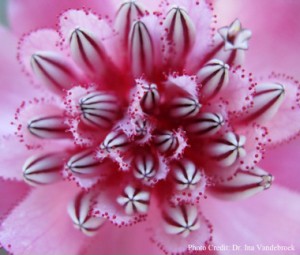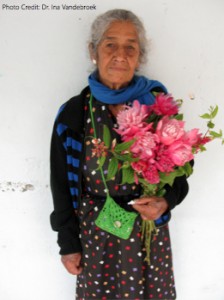The Rose of El Queremal: A Not-So-Modern Love Story
Posted in Interesting Plant Stories on March 3, 2014 by Annie Virnig
Annie Virnig is a graduate student in the Commodore Matthew Perry Graduate Studies Program at The New York Botanical Garden.
 “The beauty of this species is its undoing,” wrote New York Botanical Garden botanist James Luteyn in 1983 regarding this flower, which is native to the Andean cloud forests of Colombia. Since then, his words have only become truer.
“The beauty of this species is its undoing,” wrote New York Botanical Garden botanist James Luteyn in 1983 regarding this flower, which is native to the Andean cloud forests of Colombia. Since then, his words have only become truer.
The founders of El Queremal in southwestern Colombia were inspired to name the town in honor of this beautiful and intoxicatingly fragrant flower that grows there, called quereme de la rosa by locals and known scientifically as Cavendishia adenophora.
Long before settlers reached El Queremal, the indigenous people of the area, the Anaconas, valued quereme de la rosa and believed it to be a charm for love and enchantment. The story goes that if a woman wears the quereme flower, its beautiful fragrance will inspire men to fall in love with her and women to be drawn to her in friendship. Likewise, if a man wears the flower in his lapel, women will flock to him. One story told in El Queremal involves a man who could not rid himself of the women who pursued him after he wore the quereme, so he ran away to live the rest of his days deep in the rainforest.
Quereme de la rosa belongs to one of many closely related species of the plant family Ericaceae (the blueberry family), all called queremes, with great cultural and economic significance for the population of El Queremal. I saw queremes firsthand and learned about their cultural and ecological importance last July on an expedition to El Queremal with Dr. Ina Vandebroek, a Botanical Garden scientist who studies ethnobotany, or how people use plants. Now, as a second-year student in the Graduate Studies Program, I am developing my doctoral research to study these quereme species with an interdisciplinary perspective, including their chemical and genetic properties, their evolutionary relationships, and the cultural and economic roles they play in people’s lives.
One focus of my interdisciplinary doctoral research will be to investigate the history of the cultural use and local classification of quereme de la rosa and other quereme species important in the area, showing the degree to which quereme species recognized locally correspond to scientifically recognized botanical (Linnaean) species. I also hope to work with both quereme collectors and local conservation organizations, identifying points of tension between conservation ethics and conservation practices to inform future initiatives to help these species survive.

Because of their ecological and socioeconomic importance, conservation of the queremes is becoming an urgent issue. They occupy an extremely restricted natural range in the microhabitats characteristic of the Chocó bioregion along the Colombian Pacific coast and are found nowhere else. During the last 50 years they have been overharvested because of the demand for them in markets across Colombia. The tension here between their role as a cultural symbol and as an economic mainstay is evident. Despite the local desire to harvest the plants sustainably—a goal that has been aided by recent cultivation of several species—they are becoming increasingly rare in their native habitat.

